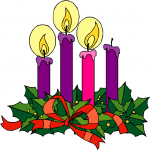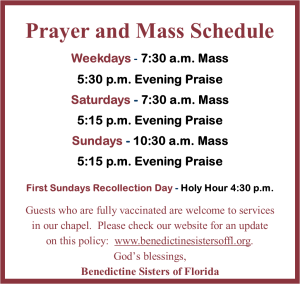 This past week we celebrated some feasts that are frequently connected in our minds to the customs of Christmas time: St. Nicholas shoes, the Immaculate Conception of Mary, and next week we’ll honor our Lady of Guadalupe (roses in the snow) and St. Lucy, patron of the sight-limited and blind, with crowns of lit candles and cat cookies. And, this weekend the liturgy says: “take a breather – we’re halfway to Christmas.”
This past week we celebrated some feasts that are frequently connected in our minds to the customs of Christmas time: St. Nicholas shoes, the Immaculate Conception of Mary, and next week we’ll honor our Lady of Guadalupe (roses in the snow) and St. Lucy, patron of the sight-limited and blind, with crowns of lit candles and cat cookies. And, this weekend the liturgy says: “take a breather – we’re halfway to Christmas.”
Two figures, John the Baptist and Mary the Mother of God, stand out in the Advent Gospels as we prepare for Christ’s birth. John’s purpose in preparing us for Christ is fourfold: to bring knowledge of salvation, to bring forgiveness of sins, to give light in the darkness, and to guide us in the way of peace.
First, John models for us simplicity. He lived a simple life, keeping his focus on Christ in everything he did. We, too, strive to keep our focus on the true purpose of Christmas – the celebration of the birth of our Lord – much more than gift-giving.
Second, John lived a life of fasting. We too can make little sacrifices for others during Advent, thereby keeping the focus off of consumerism and placing it on relationships – with Christ and with others.
Third, John forgave others. We too can make a commitment to forgive others this Advent. In forgiveness therapy there is a belief that anger is due to a lack of forgiveness and a lack of forgiveness is due to anger. The two feed off each other. Thus, if you are feeling angry, practice forgiveness. What a great time to offer the gift of forgiveness to a love one, a confrere, or a coworker.
Fourth, John lived a virtuous life. We too can focus on increasing the positive in our lives and letting go of the negative. Following John’s lead is a great way to our lives peaceful.
The Blessed Virgin Mary is the other figure that prepares us for Christ’s birth. Mary’s face in many sculptures, icons and images exemplifies the peace she must have exuded in her life. Her peace came from putting Christ at the center of all she did. Like Benedict says (in his Rule): put nothing whatever ahead of Christ.” Mary’s “yes” was the ultimate gift she could give and she offered it peacefully.
We ask ourselves: what is my best? What can I give to God this advent season?
This story, told in this month’s Catholic Digest illustrates the lesson that God cannot not be undone is generosity. I quote: When I was a child, my parents would have my siblings and me create a list of Christmas gifts we wanted that year. Then, they would find children in need who were the same age and gender as we were. My parents then asked us to give our No. 1 item to that child and cross it off our list. It was a huge sacrifice for us – and a lesson in giving our best to God.
One year my brother wanted an action figure and was very upset that he was being asked to give that same action figure to another boy who had very few, if any, toys. He balked at giving this best and did it only reluctantly that year. Once it was gone, he knew it was off his list for the year, at least from my parents. However, our aunt, not knowing our family practice, or what my brother’s best gift was and that he had given it away, gave him that same action figure for Christmas. The joy on his face was radiant, as he exclaimed: “I’m giving God my best gift every year!”
What is your best give? Just like the Blessed Virgin Mary, what can you give to Christ this year, knowing that the reward for giving is beautiful?
In tomorrow’s Entrance Antiphon (from Paul to the Philippians) the Church exhorts us: “Rejoice in the Lord always; again I say, rejoice!” The antiphon reminds me of a hymn made popular by S. Miriam Therese Winter, with her peppy guitar rendition of “God Loves a Cheerful Giver.” You may remember it – if so, sing:
God loves a cheerful giver, give it all you’ve got,
He loves to hear you singing when you’re in an awkward spot,
When the odds are up against you,
It’s time to stop and sing – Praise God,
to praise Him is a joyous thing!
Do what the church says, “Rejoice in the Lord always; again I say, rejoice.”


